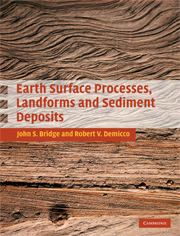Book contents
- Frontmatter
- Contents
- Acknowledgments
- Figure credits
- PART 1 Introduction
- PART 2 Production of sediment at the Earth's surface
- PART 3 Fundamentals of fluid flow, sediment transport, erosion, and deposition
- PART 4 Environments of erosion and deposition
- 13 Rivers, alluvial plains, and fans
- 14 Lakes
- 15 Coasts and shallow seas
- 16 Arid environments
- 17 Glacial and periglacial environments
- 18 Deep seas and oceans
- PART 5 Sediment into rock: diagenesis
- PART 6 Long-term, large-scale processes: mountains and sedimentary basins
- References
- Appendix: Methods of study of Earth surface processes, landforms, and sediments
- Index
- Plate section
14 - Lakes
from PART 4 - Environments of erosion and deposition
Published online by Cambridge University Press: 05 June 2012
- Frontmatter
- Contents
- Acknowledgments
- Figure credits
- PART 1 Introduction
- PART 2 Production of sediment at the Earth's surface
- PART 3 Fundamentals of fluid flow, sediment transport, erosion, and deposition
- PART 4 Environments of erosion and deposition
- 13 Rivers, alluvial plains, and fans
- 14 Lakes
- 15 Coasts and shallow seas
- 16 Arid environments
- 17 Glacial and periglacial environments
- 18 Deep seas and oceans
- PART 5 Sediment into rock: diagenesis
- PART 6 Long-term, large-scale processes: mountains and sedimentary basins
- References
- Appendix: Methods of study of Earth surface processes, landforms, and sediments
- Index
- Plate section
Summary
Introduction
Lakes cover approximately 1% of the Earth's continental areas. They range in size from small ponds and wetlands less than a few hundred square meters up to large lakes such as Lake Superior in North America (82,410 km2). The brackish Caspian Sea (374,000 km2) is generally regarded as the world's largest lake, but the Caspian Sea and Black Sea are both remnants of the Tethys ocean, and have been connected and disconnected from the Mediterranean Sea and the world ocean during the past 5 Myr (Meybeck, 1995). Lake depths vary greatly. Lake Baikal in Russia (31,500 km2) is up to 1,640 m deep, the maximum depth of Lake Superior is ~400 m, and most large lakes are a few tens of meters to a few hundreds of meters deep. Some large lakes in semi-arid areas can be quite shallow. Lake Chad in central Africa (25,000 km2) has a maximum depth of 7 m whereas Great Salt Lake, Utah, USA (4,600 km2) has a maximum depth of ~8 m. The depth of large ephemeral lakes may be as much as 5 m during floods.
Lakes are important because they are reservoirs of freshwater, sources of fish, shipping corridors, sites of recreational activity, and sites of chemical sedimentation. Large lakes influence regional climates and hydrological regimes. Many modern lakes respond to environmental changes in quite dramatic fashion.
- Type
- Chapter
- Information
- Earth Surface Processes, Landforms and Sediment Deposits , pp. 462 - 472Publisher: Cambridge University PressPrint publication year: 2008



